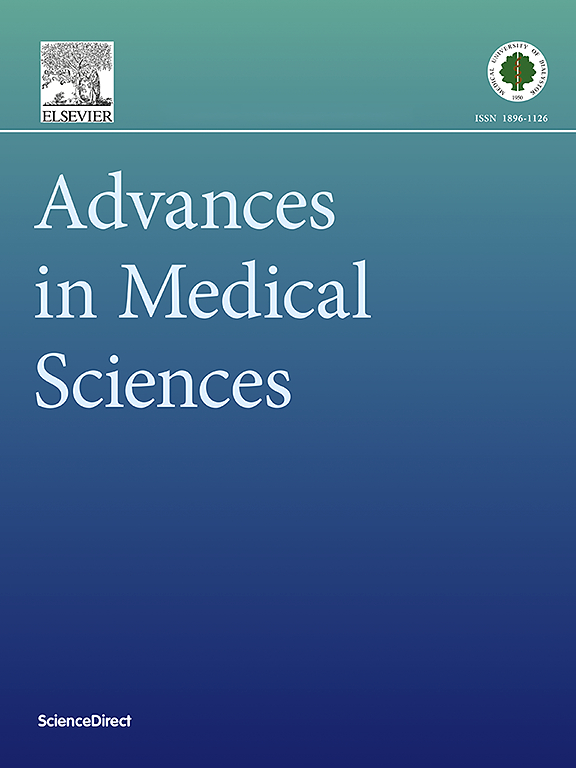胎铁蛋白含量与新生儿出生尺寸的初步研究。
IF 2.6
4区 医学
Q3 MEDICINE, RESEARCH & EXPERIMENTAL
引用次数: 0
摘要
目的:积累在胎便铁蛋白量可能提供新的产后见解宫内铁稳态和新生儿准备产后期。胎儿铁储存和胎儿生长最动态的增加发生在妊娠晚期。材料与方法:本研究纳入122例妊娠36 ~ 41周出生的新生儿,出生体重2650 ~ 4960 g,出生体长50 ~ 60 cm。在出生后通过的第一次胎中,通过ELISA测定每克胎中铁蛋白的含量。结论:胎铁蛋白含量在妊娠36 ~ 41周期间的系统性下降可能表明胎儿适应产后生活的机制逐渐成熟。确定胎粪铁蛋白量的临界值有助于新生儿出生后的最佳管理。本文章由计算机程序翻译,如有差异,请以英文原文为准。
Meconium ferritin amounts and birth size of neonates: a pilot study
Purpose
Ferritin amounts that accumulate in the meconium may provide new postnatal insights into intrauterine iron homeostasis and neonatal preparedness for the postnatal period. The most dynamic increases in fetal iron stores and fetal growth occur during the third trimester.
Materials and methods
This study involved 122 neonates born between 36 and 41 weeks of gestation, with birth weights from 2650 g to 4960 g and birth lengths ranging from 50 cm to 60 cm. Ferritin amounts per gram of meconium were determined via ELISA in the first meconium passed after birth.
Results
A significant week-by-week increase in the birth weight and length (p < 0.05) was accompanied by decreasing meconium ferritin amounts (p = 0.021) across the gestational age range of 36–41 weeks. There were negative correlations (p < 0.05) between the systematic decrease in meconium ferritin amounts and the gestational age across the same range (r = -0.18) and between ferritin amounts and the birth weight and length of newborns (r = -0.20 and r = -0.31). Neonates born at 36–37 weeks of gestation had lower birth weight and length, while their meconium ferritin amounts were nearly twice as high as in neonates born at 38–39 weeks or 40–41 weeks (p < 0.05).
Conclusions
Systematic decreases in meconium ferritin amounts from 36 to 41 weeks of gestation may suggest a gradual and gestational age-appropriate maturation of the mechanisms responsible for adaptation of the fetus to postnatal life. Determining a cut-off value for meconium ferritin amounts could aid in optimal management of newborns after birth.
求助全文
通过发布文献求助,成功后即可免费获取论文全文。
去求助
来源期刊

Advances in medical sciences
医学-医学:研究与实验
CiteScore
5.00
自引率
0.00%
发文量
53
审稿时长
25 days
期刊介绍:
Advances in Medical Sciences is an international, peer-reviewed journal that welcomes original research articles and reviews on current advances in life sciences, preclinical and clinical medicine, and related disciplines.
The Journal’s primary aim is to make every effort to contribute to progress in medical sciences. The strive is to bridge laboratory and clinical settings with cutting edge research findings and new developments.
Advances in Medical Sciences publishes articles which bring novel insights into diagnostic and molecular imaging, offering essential prior knowledge for diagnosis and treatment indispensable in all areas of medical sciences. It also publishes articles on pathological sciences giving foundation knowledge on the overall study of human diseases. Through its publications Advances in Medical Sciences also stresses the importance of pharmaceutical sciences as a rapidly and ever expanding area of research on drug design, development, action and evaluation contributing significantly to a variety of scientific disciplines.
The journal welcomes submissions from the following disciplines:
General and internal medicine,
Cancer research,
Genetics,
Endocrinology,
Gastroenterology,
Cardiology and Cardiovascular Medicine,
Immunology and Allergy,
Pathology and Forensic Medicine,
Cell and molecular Biology,
Haematology,
Biochemistry,
Clinical and Experimental Pathology.
 求助内容:
求助内容: 应助结果提醒方式:
应助结果提醒方式:


